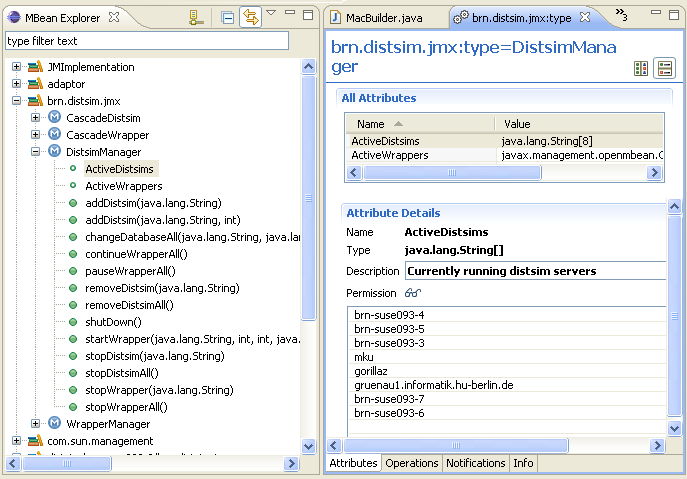Brn.Sim
The Berlin RoofNet Simulator (Brn.Sim) is wireless mesh network simulator based on JiST/SWANS.
Brn.Sim Core
Simulator Core
Physical Layers
IEEE 802.11abg Physical Layer
- Models for IEEE 802.11b (DSSS) and a/g (OFDM)
- BER Model from yans, ns-3
- Shadowing and Fading (both correlated/uncorrelated in time) from ns-2/SWAN/GloMoSim
- TODO spatially correlated shadowing
- Propagation Delay Model
- Transmit Diversity Model
- Brn.Phy
IEEE 802.11abg Multi-Channel Support
Tbd.
IEEE 802.11abg Multi-Bit-Rate Support and Bit-Rate Selection
Tbd.
IEEE 802.11e
Tbd.
Brn.Click: Integration of the Click Modular Router API
Tbd.
Brn.Gui

The Brn.Gui is a user interface for the Brn.Sim simulator. It is able to control the simulation execution like a debugger. It visualizes simulation results which are specified in simulation code via the Brn.Measure framework. Furthermore, it is also a result browser for already completed simulations which were executed by the Brn.DistSim distributed simulation framework and stored in the Brn.Db storage. For details see Brn.Gui
Brn.Measure
Tbd.
Brn.Db and Brn.DistSim
DistSim is a framework for defining, executing and collecting the results of multiple similar simulations. Core component is the Wrapper, which obtains simulation definitions from a database and executes it. Furthermore, there are JMX Mbeans for the distributed management of wrapper instances.


Scenario Creation via Brn.Builders
Tbd.
Do not forget to define Getter/Setter for each Member of the Parameter Class!
Wishlist
- TCP from ns-3 or yans (http://yans.inria.fr/code/tcp-bsd/?file/08a99283d359/tcp-bsd-foo/)
- IP Stack from OppBSD
- Channel simulation via chsim
- Integration of JTrana Trace Analyzer
- Shadowing correlation according to Integration of physical phenomena into an experiment-based propagation model
- Energy contour plot from SNSim
- Antenna/Beamforming patterns [1]
- yavista integration
- Mobility traces support [2]